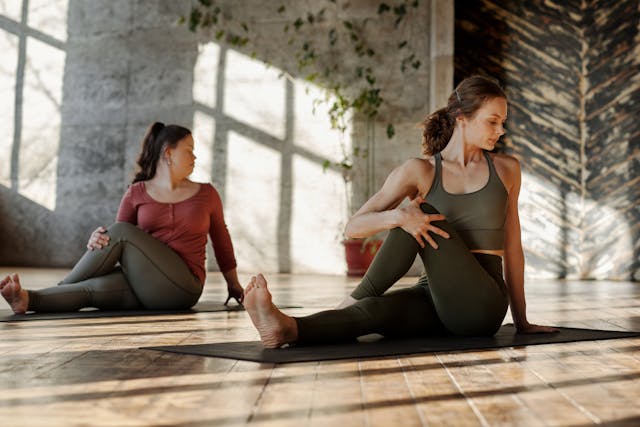Flexibility training and pain reduction typically require more than simple stretching exercises; it is crucial to establish mobility training. They allow the improvement of general functional mobility, muscle strength, and joint mobility in patients. Whether you need to overcome stiff muscles before work or training for a competition, the mobility exercise routines offer major advantages. Here are ten of these exercises that will help in increasing your flexibility and reducing things such as soreness so that you can have a much easier life.
1. Dynamic Hip Flexor Stretch
The dynamic hip flexor stretch is designed for the hip flexors muscle group whose responsibility it is to assist an individual in maintaining and moving in any given posture. Beginners should stand upright with one leg in front of the other, but the front knee is aligning itself with the front ankle. Maintaining your body upright, gently thrust your hips forward. The front of your hip and thigh should feel stretched as you push forward. Go back to the beginning and alternate your legs. This exercise will help avoid low back pain as it helps to tone up the muscles around the hip joint and increases its flexibility.
2. Thoracic Spine Rotation
The thoracic spine, or the upper back region, tends to become rigid due to factors such as sitting at work and adopting a poor posture. To perform thoracic spine rotation begin by standing or sitting position with the feet kept at approximately shoulder width apart. Extend your arms above your head, putting your palms to the back of your head, and then twist your torso to one side while keeping your hips in a straight position. Keep the position for several seconds and then go back to the starting position, turning on the opposite side. This exercise stretches out the rotation of the upper spine and becomes beneficial for shoulder and neck pain because it improves the flow of the spine.
3. Standing Quadriceps Stretch
The standing quadriceps stretch can be used for the relief of tension in the quadriceps muscles which are the huge muscles at the anterior part of the thighs. Stand on the right leg and put your left foot backward. Now, take the left hand, place it around the left ankle, and try to pull it towards the back side of the buttocks. It is also necessary to minimize the distance between the knees and to stand vertically. Try to maintain the position for at least 20-30 seconds before swapping the legs. This exercise is ideal when it comes to enhancing the flexing of the quadriceps muscles, hence reducing future knee pains and easy mobilization, exercising and doing other activities.
4. Cat-Cow Stretch
Cat-Cow is a common type of yoga exercise, which is extremely useful for developing the elasticity of the spine. The starting position is on your stomach, your legs spread wide apart, and your palms on the floor at your shoulder width apart. Take a deep breath and then bend the torso back towards the ceiling as if sitting on the tailbone alone (Cow Pose). Breathe out and arch the spine, bring the chin to the chest, and engage your abdomen (Cat pose). Do this pattern several times for a few breaths. This mobility training exercise improves the flexibility of the spinal muscles and assists with decreasing the stiffness in the back and the need for better posture and less Pain in the lower back area.
5. Ankle Dorsiflexion Stretch
Dorsiflexion of the ankle is the movement by which the foot is moved towards the tibia; this is quite vital in movements like walking as well as running. To do this stretch, stand in the lunge-like position but face the foot in such a manner that the heel is on the ground while the toes are pointing sideways to the knee of the lead leg. Bend your body forward while leaning with your feet to develop pull in your calves and at the back of your lower leg. Take a deep breath and raise the leg up and keep it up for 20-30 seconds and then switch the side. This is useful in increasing the flexibility of the ankle and it is used in the rehabilitation of athletic injuries and in the correction of balance and gait.
6. Child’s Pose
Child’s Pose is a restorative yoga position that provides back, hips and thigh a break from tensing. In this position, begin by kneeling on the floor with the toes inclined to touch each other while the knees are apart. Kneel on the floor with your bottom resting on your toes and your arms in front of you, bend your upper body forward. Let your head bow down touching the ground and stay in this posture for sometime. This helps become a good preparation for people with lower back pains or tight hip muscles, as it helps stretch the spine as well as back and hips muscles.
7. Shoulder Wall Stretch
The shoulder wall stretch targets the region around shoulders and chest which are always troubled by desk workouts and slouching. Standing with your back against the wall, raise your and lay your hand against the surface of this wall. Point your fingers to the wall and bend your elbow and then turn your body around in the opposite direction and try to feel the stretch right up to your shoulder towards your chest muscles. Try to push for 20 to 30 seconds and after that change sides that you are pushing with. This exercise’s intention is to mobilize and strengthen the chest muscles and thus help reduce the rigidity of the shoulders.
8. Lying Hip Abductor Stretch
The lying hip abductor stretch increases hip flexibility by stretching muscles found on the lateral part of the hips and thighs. Meanwhile, avoid slouching and place your feet flat on the floor if you are using a chair. Twist an ankle over the opposite knee so that it is ‘locked’ in a ‘figure-four’. While maintaining the position of the crossed leg, you need to pull the bottom leg towards the chest. Extend this position for approximately 20-30 seconds before changing to the other side. This exercise is useful for hip abductors that can make muscles around the hips looser, flexible, and comfortable, hence enhancing the efficiency of the overall movements.
9. Hamstring Stretch with a Strap
Hamstring stretch with the strap is a suitable one for increasing the flexibility of the hamstrings as well as the lower back portion. Lay with one leg straight and the other folded. Slide a strap or a towel under the ball of the extended foot and then towards you, with the knee straight. Maintain the stretch for 20-30 seconds then repeat it with the other leg. This exercise is useful, particularly for stretching the hamstring muscles so as to build capacity as well as increase flexibility so as to eradicate Pain around the region of the lower back and also increase flexibility in the legs.
10. Dynamic Lunges
Dynamic lunges are used in physical fitness to enhance lower body flexibility and strength. First, stand with your legs slightly wider than shoulder-width apart. Take a step forward with the left foot into a lunge position, aligning the knee with the heel of the same foot and the right knee bent slightly and down. Swing the preceding foot and come to the original stand position. Switch the legs with each lunge. This exercise specifically targets the quadriceps, hamstrings, glutes, and hip flexors while also improving hip mobility and core stability.
Conclusion
Adapting these mobility exercises into your daily life can be incredibly beneficial in promoting flexibility, decreasing Pain, and promoting the quality of movements. Mobility training is essential in ensuring that the joints remain healthy, reduce instances of injury, and encourage increased mobility. By practicing these exercises on a daily basis you can enjoy increased comfort in occupational and other activities as well as in sports.
Also Read: Healthy and Insured: Weighing the Benefits of Health Sharing Plans






